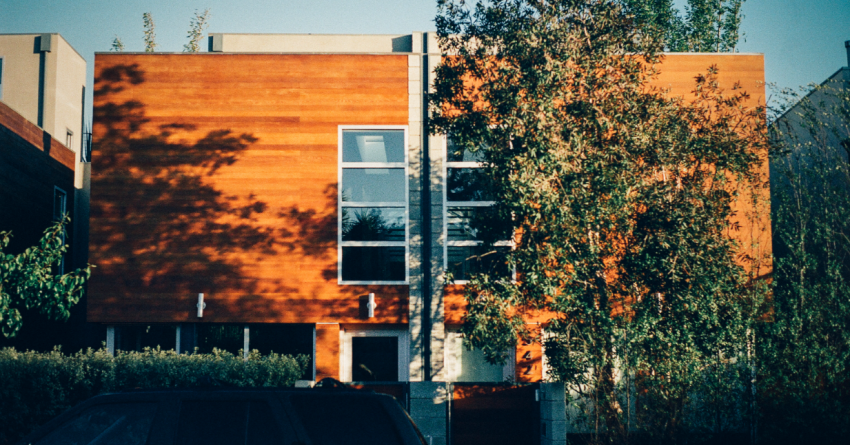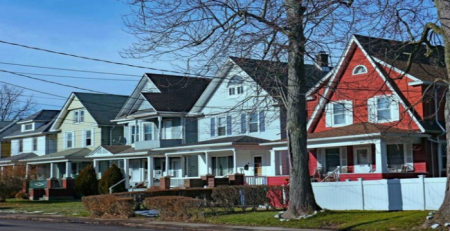Saving money with a semi-detached house (aka: Duplex in BC)
For buyers dead-set on moving into a single family house, there seems to be little room to budge. The price-tag for detached urban homes is out of reach for many, but that’s doesn’t mean a move to a condo apartment is the right step. For some buyers, no amount of amenities or nearby transit stops are enough to give up on a private backyard, more living space or the freedom to renovate. Lengthy commute times be damned.
From a price-point perspective, a semi-detached house or a town home can make good financial sense. Here’s what you need to know about these two housing types.
What is a semi-detached house? (Duplex)
A semi-detached house (semi for short) is a single family residence that is attached to its direct neighbor on one side through a common wall.
Traditionally, semis are built side-by-side, but there is a variety of semi-detached houses that are built front-to-back facing opposite directions (many of these front-to-back semis can be found in Lower Mainland, B.C.).
Although semis share a wall, each sits on a distinct plot of land and are predominantly available as freeholds. So when you buy a semi-detached house, you own both the structure and the segment of land your dwelling is built upon (that doesn’t include your attached neighbors land of course).
Typically, semi-detached houses are smaller—both in actual living space and lot sizes—compared detached properties. A semi also has the obvious caveat of sharing a wall with another household (meaning less control over privacy and noises from neighbors). On the other hand, detached homes are stand alone structures free of any connecting walls, granting for greater seclusion.
The average semi-detached house is larger than a town-home and only has one attached neighbor rather being sandwiched between two. Consequently semis are far more desirable in comparison.
Semi-detached homes represent the second most popular type of freehold housing in the Greater Toronto Area, accounting for approximately 9% of the overall market. Detached houses and freehold townhouses represent 47% and 8% respectively.
Semis are known as duplexes in B.C. This is not to be confused with a GTA-duplex, which is typically one house that is sold with only one title of ownership, but consists of two separate living units.
What is a townhouse?
Townhouses are single family homes built in a row, where each individual home is attached to the next by at least one connecting wall. Nestled on smaller lots than a traditional detached or semi-detached homes, townhouses are often constructed narrowly and are two to three storeys tall. Townhouses open up to the street level and have smaller yards.
A townhouse generally falls into two types of ownership – freehold and condominium.
In a freehold town-home, the homeowner owns the house and the plot of land it sits on. In a condominium townhouse however, the land belongs to a Home Owners Association (HOA), where residents are obliged to pay monthly maintenance fees while sharing ownership of the common spaces, such as the gym, yard, etc. (similar to a traditional condo apartment). Condominium town-homes are more affordable than freeholds by about 26%, according to the Toronto Real Estate Board (TREB).
Price of semi-detached home
House hunters not willing to compromise on the idea of owning a freehold but still want some extra financial wiggle room can save big by opting for a semi-detached house over a conventional detached property.
According to real estate data for the GTA, the average sold price of a semi-detached house sits at around 35% less than a detached dwelling—a substantial double digit gap.
When pitting semis against town homes on the affordability front, the latter comes out on top. The average freehold town in the GTA sells for 8% below what a semi-detached does. That gap is even more pronounced when factoring condo-town homes in to the equation.
To get more granular, we listed semi-detached house prices in 2016 so far on a per region basis.
- Avg. Price: Semi Detached House Toronto: $861,185
- Avg. Price: Semi Detached House Peel Region: $568,374
- Avg. Price: Semi Detached House York Region: $730,149
- Avg. Price: Semi Detached House Durham Region: $426,174
- Avg. Price: Semi Detached House Halton Region: $605,967
Lower price semis attract attention
Keep in mind, however, that a lack of supply in the GTA has made buying any property a challenge—and with a lower list price, semi-detached properties often attract a lot of attention. While that does provide hurdles for house hunters, it bodes well for sellers. As a result, semi-detached house values climbed 16%, year-over-year, from Dec. 2015 to Dec. 2016.
Price of town home
According to TREB, the price percentage difference between a freehold townhouse and detached home in the Greater Toronto Area is around 44% in 2016—with detached homes costing more. The difference between condo-towns and detached properties is far more pronounced with an over 60% price difference, according to 2016 figures.
Why are detached homes more expensive than town homes?
For one, detached homes tend to be larger than townhouses, both in terms of actual square footage and lot size. Detached homes are also more desirable because they offer greater privacy, as they do not share any walls with a neighboring house.
Residents of a detached home can also exercise greater control over their property (within the confines of zoning laws, of course). They are free to paint, renovate and build extensions in any way they please. The same isn’t true for town-home owners where restrictions are imposed by either Home Owners/Condo Associations or structural limitations stemming from their attached neighbors.
Supply and demand is another key factor that has influenced prices for both town homes and detached homes, particularly in Toronto. With the roll out of new provincial policies aimed at increasing densification and limiting housing developments in greenbelt areas, construction of new real estate is directed away from low-rise homes and towards higher density residences (such as condo apartments). This has led to constraints in the supply of new low-rise family style housing.
As the real estate market is unable to keep up with demand, greater pressure is placed on the existing stock of single family houses, in turn, driving up prices at a rapid pace.
Price growth has been more noticeable in detached properties due to the fact they are more coveted by buyers. The average price of a detached home now peaks beyond one million dollars in the City of Toronto.
While both detached and townhouse prices continue to climb, town homes are still the more affordable option for first time buyers and young families who wish to make the leap from renting, or upgrade from condo living.
Maintenance and renovation costs
Semis and non-strata town-homes are freeholds, which means that maintaining the home falls solely on the owner. Freeholds, unlike in a condominium, don’t offer a Home Owners Association to upkeep the property in exchange for monthly fees. Air conditioning, wiring and piping must be maintained by you.
However, there are financial perks to buying a town-home or semi-detached house versus a traditional detached home.
Smaller backyards and lot sizes means yard work takes less time in a semi-detached house. Roofs are smaller, and as a result, so are the budgets needed to maintain them. Heating and cooling costs also tend to be lower in semis compared to detached homes.
Depending on how well you get along with your attached neighbor, you may be able to share some home maintenance costs such as roof repairs.
How to take on renovations in a semi-detached house?
If you’re considering embarking on a renovation in a semi-detached house, it’s critical to keep your attached neighbor in the know from the start. It’s also important to realize there are limitations to what work can be done—especially when compared to a traditional detached home.
For small jobs, like installing new kitchen cabinets, it’s not necessary to get the neighbors involved. However, it can help foster goodwill if you inform them a minor reno is in the works, especially if hammering and noise is involved.
When it comes to aesthetic changes, consider consulting your neighbor. For instance, communicate your plans to paint your home a new color or to swap out metal railings for a custom-wood porch. While you don’t require permission from your neighbor, it’s a good idea to keep them informed of changes that will impact the look and feel of their home.
On bigger projects, informing the neighbors is a must, as is making sure all the paperwork and permits are in order. Your local building authority may even require your attached neighborhood contractually agree to the project’s go-ahead.
Before starting a reno, it’s a smart move to first have a professional contractor or home inspector assess if and how you’ll impact your neighbor and their home.
When considering a renovation or remodel, keep in mind that because semis have a shared structural wall, fewer windows can be installed and this can impact the flow of natural light in the home.
In a freehold town home, you may be restricted to the type of renovation you can complete to the exterior facade. However, almost all cosmetic updates to the interior of the unit are not restricted.
Townhouse vs. semi-detached vs. detached house
Still not sure if you’re suited to townhouse or semi-detached living, but don’t want to cough up the price-tag of a detached urban home? Consider this summary of differences between a semi-detached house and a detached home:
Price: Town-homes are the most affordable option, although semis offer more of a house experience at a more affordable price than a detached home. According to real estate data for the entire GTA, the average sold price of a semi-detached house sits at around 30% less than a detached dwelling—a substantial double digit gap.
Size: Town homes are typically built as narrow, tall homes. Semis are typically wider than towns-homes, but smaller—both in actual living space and lot sizes—compared to detached properties.
Privacy and noise: Town-homes and semi-detached homes share walls, which means noise can travel through the wall from the attached neighbors’ place. Detached homes, on the other hand, are far less prone to noise disturbances given they are stand alone structures.
Maintenance: Smaller backyards and lot sizes means yard work takes less time in a townhouse or semi-detached house compared to a detached. Roofs are smaller, and as a result, so are the budgets needed to maintain them. Heating and cooling costs also tend to be lower in semis versus detached homes given their smaller sizes and the fact there’s a shared wall.
Select home repair and maintenance costs can be split with your attached neighbor in a freehold townhouse or semi—allowing for potential cost savings.
Renovation: In a freehold town home or semi-detached house, there are certain legal and structural limitations on what projects can be done, as it may impact your attached neighbour. In a detached home, you’re completely and utterly free to renovate as you like (within the confines of zoning laws of course).
Semi-detached vs. duplex
Semis are two distinct homes (with separate owners and lots) connected through one common wall and built side-by-side to each other.
A duplex is a property on a single lot with two distinct living spaces. However, from a legal perspective a duplex is a single property existing on a single piece of land.
In B.C., however, a duplex is actually the same as a GTA semi—a home that shares a common wall with a neighbor, but is considered a separate and distinct legal parcel of land and dwelling.











